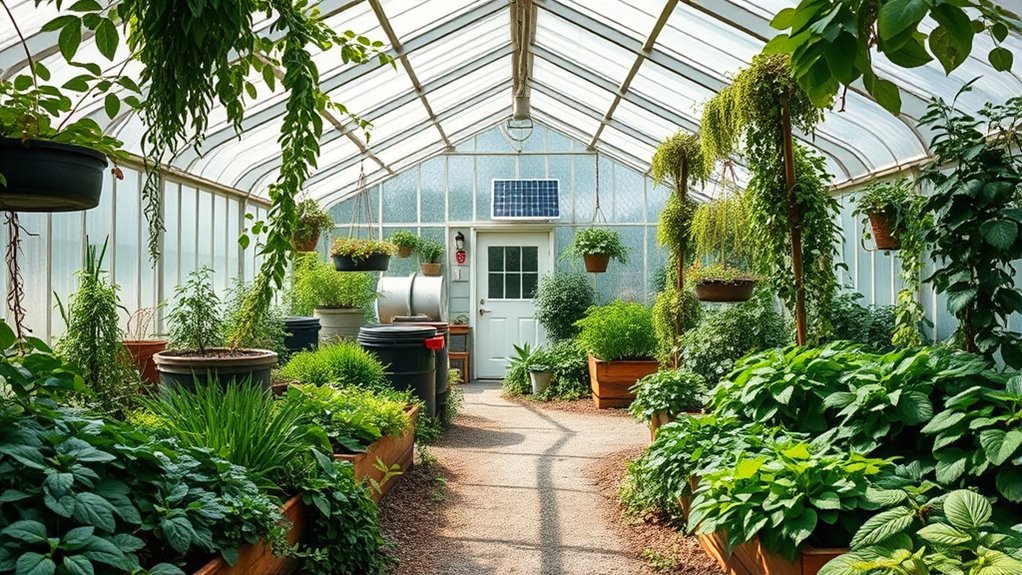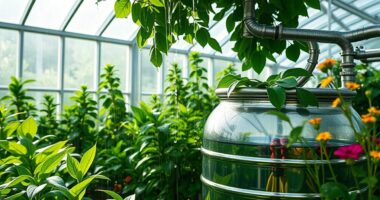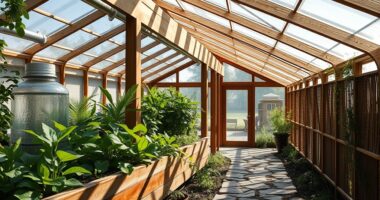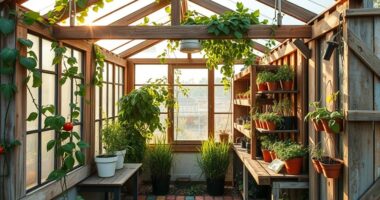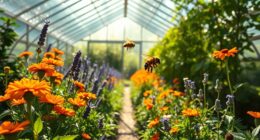To design a self-sustaining ecosystem in your greenhouse with permaculture, focus on combining plant pairings that enhance growth and control pests naturally. Incorporate soil regeneration practices like composting and mulching, and use water-efficient systems to conserve moisture. By integrating these principles, you’ll create a resilient environment that minimizes external inputs and promotes healthy, productive plants year-round. Continue exploring these strategies to discover even more ways to optimize your greenhouse’s sustainability.
Key Takeaways
- Incorporate companion planting to naturally repel pests and enhance plant health within the greenhouse ecosystem.
- Use organic soil regeneration methods like composting and mulching to maintain fertile, resilient soil.
- Design plant pairings that optimize space, resource use, and mutual support for a balanced environment.
- Implement water-efficient irrigation and mulching to conserve moisture and sustain plant growth year-round.
- Create a self-sustaining system by integrating natural processes that reduce external inputs and promote ecosystem resilience.
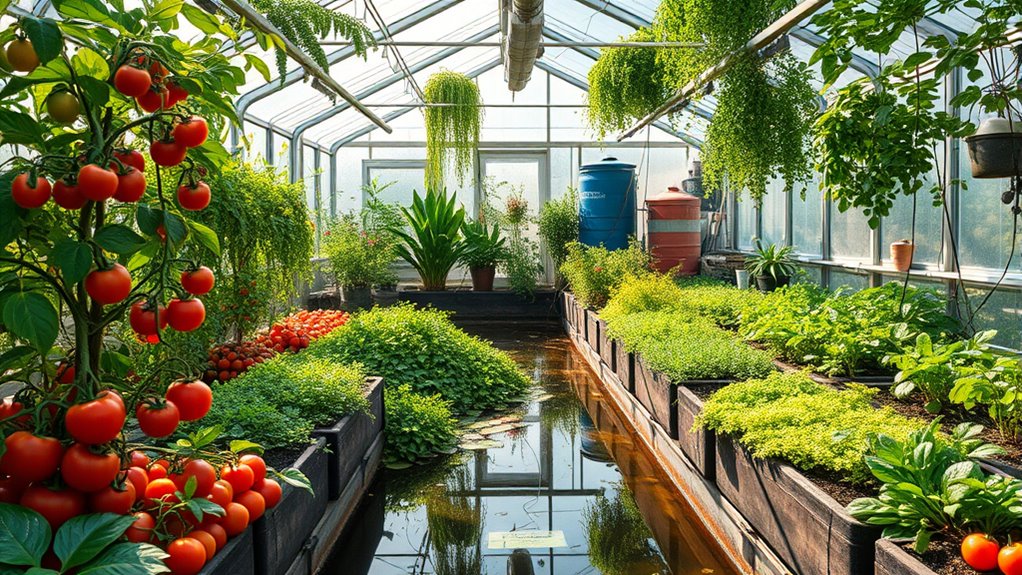
Permaculture in the greenhouse offers an innovative way to create a sustainable and productive environment year-round. By integrating natural principles, you can design a system that minimizes external inputs while maximizing yields. One of the core techniques in this approach is companion planting, which involves strategically pairing plants to support each other’s growth. When you plant certain crops together, they can repel pests, attract beneficial insects, and improve nutrient uptake, reducing the need for chemical interventions. For example, basil planted near tomatoes can deter pests like aphids, while beans fix nitrogen in the soil, benefiting neighboring plants. This natural symbiosis creates a resilient ecosystem that needs less maintenance and input, making your greenhouse more sustainable.
Permaculture in the greenhouse promotes sustainability through companion planting and natural soil regeneration.
Soil regeneration is another essential aspect of permaculture in the greenhouse. Healthy soil is the foundation for vigorous plant growth, and in a controlled environment, it’s indispensable to maintain its vitality. Instead of relying on synthetic fertilizers, you focus on building soil organically through composting, mulching, and cover cropping. Each time you add organic matter, you enhance the soil’s structure, encourage beneficial microorganisms, and improve nutrient cycling. Over time, this process leads to richer, more fertile soil capable of supporting diverse plant life without external supplements. As you observe and adapt, you’ll notice the soil becoming more resilient, better at retaining moisture, and less prone to erosion or nutrient depletion. Expiring vape juice and other organic matter can be composted directly into your soil to further support this process.
In your greenhouse, implementing companion planting and prioritizing soil regeneration work hand in hand. You select plant combinations that naturally protect each other and replenish the soil’s nutrients simultaneously. For instance, planting deep-rooted vegetables alongside shallow-rooted herbs creates a dynamic system that maximizes space and resource use. Mulching with organic material not only conserves moisture but also feeds the soil as it decomposes, further supporting regeneration efforts. Additionally, incorporating permaculture principles into your design can guide sustainable decision-making and plant selection, creating a balanced ecosystem. Using water-efficient irrigation methods can further reduce water consumption and support plant health, especially in controlled environments. By maintaining this cycle, you’re fostering a self-sustaining environment where plants support each other, pests are kept in check, and the soil continually improves.
This approach transforms your greenhouse into a living ecosystem that sustains itself over time. You become less dependent on external inputs, reducing costs and environmental impact. As you refine your plant pairings and soil practices, you’ll find your greenhouse thriving with healthy, productive plants all year round. Permaculture principles empower you to create a balanced, resilient system that mimics natural processes, giving you a sustainable, productive oasis right inside your own space.
Frequently Asked Questions
How Do I Start Designing a Permaculture Greenhouse From Scratch?
To start designing a permaculture greenhouse from scratch, focus on creating a balanced system. Use composting techniques to enrich your soil naturally and guarantee healthy plant growth. Implement water harvesting methods like rain barrels to conserve water and maintain moisture levels. Plan your layout to maximize sun exposure and plant diversity, encouraging beneficial relationships. Keep your design adaptable, observing and adjusting as you go to develop a thriving, self-sustaining ecosystem.
What Are the Best Plant Combinations for a Self-Sustaining Ecosystem?
You should focus on selecting plant combinations that promote companion planting and increase plant diversity. Mix nitrogen-fixing legumes with leafy greens, herbs, and flowering plants to attract beneficial insects. Incorporate root crops with taller plants to maximize space. This diverse pairing creates a balanced ecosystem, reduces pests naturally, and guarantees healthy growth. By thoughtfully combining plants, you build a self-sustaining greenhouse that supports continuous productivity with minimal external input.
How Can I Control Pests Naturally in a Permaculture Greenhouse?
When it comes to pest control, you don’t want to put all your eggs in one basket. Rely on natural methods like companion planting, which attracts beneficial insects that prey on pests. Biological control is your best friend here—introduce predator insects or use organic sprays to keep pests in check. Together, these methods help you maintain a healthy, balanced greenhouse without resorting to chemicals.
What Sustainable Energy Sources Are Suitable for Greenhouse Systems?
When considering sustainable energy sources for your greenhouse, solar power and wind energy are excellent options. You can install solar panels to harness sunlight and generate electricity, reducing reliance on fossil fuels. Wind turbines work well if your location has consistent wind, providing additional power. Combining these renewable sources guarantees your greenhouse remains eco-friendly and energy-efficient, supporting your goal of creating a self-sustaining ecosystem.
How Do I Maintain Soil Fertility Over the Long Term?
To maintain soil fertility long-term, you should regularly add organic compost and natural soil amendments. These enrich the soil with essential nutrients and improve its structure. Avoid synthetic fertilizers, which can harm the ecosystem. Incorporate cover crops and crop rotation to prevent depletion. Consistently monitoring soil health helps you adjust amendments as needed, ensuring your soil remains fertile and productive for years to come.
Conclusion
So, after all your efforts to create a perfect, self-sustaining ecosystem inside your greenhouse, it turns out nature’s just waiting for you to step back and let it do its thing. Who knew that designing with permaculture principles would lead to a thriving, low-maintenance paradise? Ironically, the more you plan and control, the more you realize that true sustainability comes from trusting nature’s own balance. Sometimes, the best method is simply to get out of the way.
